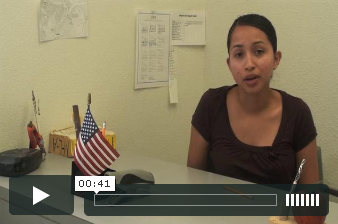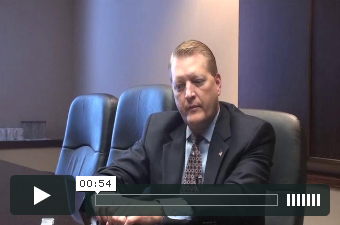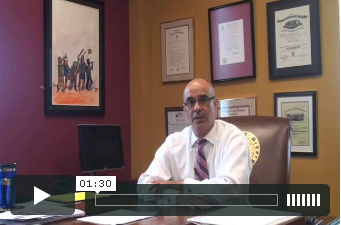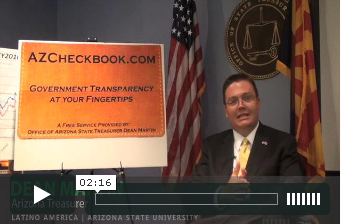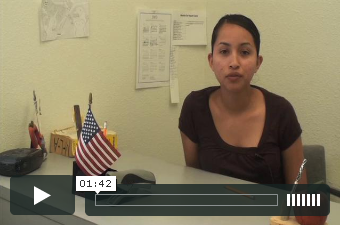Some states have passed laws denying in-state tuition and financial aid to undocumented students, many of whom grew up in the United States.
PHOENIX — Lilly is not officially an American, but she feels like one. She was 4 years old when her mother brought her into the United States illegally.
“I’m 22 years old. I’ve been here all of my life. My friends are here. My life is here,” Lilly said. “I love the U.S. more than anything.”
Lilly spent her entire educational life just like a lot of other kids in Arizona schools — from learning the ABC’s in kindergarten to joining the cheerleading team in high school.
Undocumented Students & State Aid
Explore this topic:
She was a good student, joining the Achieving a College Education program, designed by Maricopa Community Colleges for students who are the first members of their families to seek a college education. Through the ACE program, Lilly earned college credit while still in high school.
Lilly graduated from Phoenix’s Carl Hayden High School in 2006. The next year she began taking courses at her local community college. Her goal was to become a neonatologist — a doctor who cares for newborns.
But Lilly soon hit a roadblock. In 2006, the same year Lilly graduated from high school, Arizona voters approved Proposition 300, which made it illegal for undocumented students to receive state-funded financial aid or reduced in-state tuition rates.
During the 2006-2007 school year the in-state tuition rate for Maricopa County’s community colleges was $65 per credit hour. A full time, in-state student could expect to pay around $1,500 per year. The out-of-state tuition rate was $280 per credit hour, with yearly tuition around $6,700.
Having to pay out-of-state rates for courses and receiving no financial aid, Lilly was able to hang on for a year with the help from her family. Her mother, at the time a house cleaner, took on extra work and each member of the family pooled their money to help with tuition.
But in the end it was not enough, and Lilly dropped out of college to work and help with family expenses. She felt her hard work in high school and the state’s investment in her education was wasted.
“All these taxpayers have already paid for my education,” Lilly said. “They paid for me to go to school. …So, basically I just need to go to college so I can pay back and I can provide as well, but I can’t — not yet.”
Lilly’s problem is shared by undocumented students nationwide. Around 65,000 undocumented students who have lived in the U.S. for five years or longer graduate from high school each year. Depending on where they live, they can face either an easy or difficult path to a college education. If they do make it through college, they face a daunting challenge in finding good employment, because they’re not legally eligible to work in the United States.
As some states are opening pathways to affordable college for undocumented students, others are clamping down. Meanwhile, Congress continues to debate the DREAM Act, a bill that would offer a path to citizenship for undocumented students who have lived in the country for a long time.
A Patchwork of Laws
Nine states that have passed laws that allow undocumented high school graduates to receive in-state tuition rates. They are California, New Mexico, Kansas, Nebraska, Illinois, New York, Texas, Utah and Washington. Both New Mexico and Texas also offer state financial aid to the undocumented.
Arizona, Oklahoma, Georgia and South Carolina have passed laws to prevent undocumented students from receiving in-state tuition and state financial aid.
Most states have no specific laws pertaining to undocumented students. In those states all students, including illegal immigrants, follow established rules for proving residency in the state in order to receive discounted tuition or state financial aid.
Federal financial aid is only offered to legal residents.
Jose Luis, an education major at Texas A&M University, is happy to be a Texan. Jose came to the United States with his family on a temporary visa when he was 14 years old. He began attending public schools and became the first in his family to graduate from high school. Thanks to a 2005 state law known as SB 1528, Jose was able to afford college. The law allows all high school graduates in Texas — as well as international students — to receive in-state tuition and state financial aid.
“I am very proud and thankful to God for blessing me to live in Texas where to some extent I can pursue my dream which is college. I will be the first one in my family to graduate from college,” Jose Luis said. “I am very blessed to be able to go to college and I am thankful to this state that has SB 1528 because it gives me hope.”
State Versus Federal Government
As the number of illegal immigrant children in the United States has risen over the years, lawmakers and judges have faced questions about how to deal with educating them. Under the 1982 Supreme Court Decision in Plyler v. Doe all children must be offered access to a K-12 education.
As with other immigration issues, there is ongoing over the role of the federal government in deciding the fate of undocumented students.
The 1996 Illegal Immigration Reform and Responsibility Act addressed several areas regarding illegal immigration from border control to higher education.
Section 1623 of the act states “[A]n alien who is not lawfully present in the United States shall not be eligible on the basis of residence within a state (or a political subdivision) for any postsecondary education benefit unless a citizen or national of the United States is eligible for such a benefit.”
Lawmakers, activists, and government officials attempting to understand the law have often come to one of two opposite conclusions.
One interpretation of the law says undocumented students should not be allowed to get in-state tuition and state financial aid because it gives them an advantage not available to other legal U.S. residents — those who may have to pay out-of-state tuition, or who were denied admission to college on academic grounds.
The other main interpretation is that undocumented students should be allowed to receive in-state tuition and state financial aid because they are not receiving any benefit that is not generally available to those who qualify.
Lawmakers nationwide have debated whether this federal law supersedes state laws on providing aid or in-state tuition to undocumented immigrants. But even if federal law is considered supreme on this issue, confusion still remains because of differing interpretations.
The Value of an Education
Silvia Rodriguez says states that make it harder for illegal immigrants to get an education will pay a price for denying education to people who want it.
Rodriguez is a graduate student at Harvard University and an alumnus of Arizona State University. She is an undocumented immigrant whose family brought her to the United States at the age of 2. Rodriguez graduated from Phoenix’s North High School in 2005 and worked her way through college in spite of the fact that she could not receive in-state tuition or state financial aid.
“There is a bigger problem,” Rodriguez said. “Denying people an education doesn’t make people want to return to their country of origin, so what’s going to happen when those students turn 30 or 40 and don’t have an education?”
That is a question addressed in a 2009 study by the RAND Corp., a top research lab, for the U.S. government. It said higher education levels among members of a community result in more tax dollars in government coffers, less use of welfare programs and fewer people in jail.
The study looked at a limited amount of data on immigrants but concluded: “The limited research we conducted regarding the effects of increasing immigrants’ education on the public budget suggests that increases in an immigrant’s education will also yield significant benefits to taxpayers.”
But Arizona State Treasurer Dean Martin argues that illegal immigrants in the education system cost states millions of dollars up front. That’s why as a state senator he authored Proposition 300, a ballot initiative that passed in 2006 requiring all students to prove their legal residency in order to be eligible for in-state tuition and state financial aid. It is the law that Lilly says ended her college career.
Martin says the issue is a matter of fairness and economics.
“Arizona is on the front lines literally for illegal immigration, and it’s been a very expensive problem for the state,” he said.
Beyond finances, Martin said under previous state laws U.S. citizens were being denied benefits that were available to illegal immigrants.
“The state was literally subsidizing illegal immigration,” Martin said,”providing subsidies that legal U.S. residents from other states couldn’t get or that legal citizens of Arizona were on waiting lists and could not get, while someone who was here illegally was able to get it. And that doesn’t make any sense.”
Martin said the state has tracked about $15 million in savings per year because the state’s universities are required to keep track of the number of students who tried to get in-state tuition but were denied because of their immigration status. He estimates another $5 million per year may have been saved from those who never applied because they knew they would not qualify.
Who Pays for Education?
Government officials and economists differ on whether illegal immigrants actually pay for services they use, such as education.
Those against giving aid and discounted tuition rates to the undocumented say those students or their parents have not paid their share in taxes that help fund education because many receive their pay “under the table” skirting the requirement to pay taxes. They also argue that low-paid immigrant workers get tax breaks, just like other low-paid Americans, and are therefore a drain on the system.
Proponents of giving aid and in-state tuition to the undocumented argue that illegal immigrants do pay their way — through sales tax, property tax, payroll tax and some income tax, pointing out that even those immigrants who use false Social Security Numbers to gain work have taxes deducted from their paychecks. Proponents also argue that businesses gain from immigrant-provided cheap labor, which boosts the economy.
It can be difficult to track exactly which taxes pay for a students’ education in public schools since the funding is usually a combination of money from tuition and fees, combined with local, state and federal tax dollars and some grants from private organizations.
In 2007, the nonpartisan Congressional Budget Office reviewed 29 studies on the topic of immigrants and taxes and concluded that the taxes immigrants pay were not enough to offset the cost of services like education, health care and law enforcement. But the CBO also said that costs to governments were “most likely modest.”
In Oklahoma, state Rep. Dan Sullivan (R) says that a student’s parents would have had to pay full taxes for years in order to cover the cost of their child’s in-state tuition.
Illegal immigrants meet that standard, he said.
“Paying in-state tuition is the benefit of someone that’s lived in Oklahoma and paid taxes here, so I don’t think it’s unfair to say you have the same access to our higher education. But you have to pay the rates that out-of-state citizens would pay,” Sullivan said.
Sullivan was one of the sponsors of HB 1804, which requires students to prove their legal status in order to receive in-state tuition rates.
Oklahoma is probably the only state that has been on both sides of the debate over tuition and aid. In 2003 it passed a law making in-state tuition and state financial aid available to undocumented students.
Five years later, the state reversed course.
Like much of the country, Oklahoma has seen big growth in its Hispanic immigrant population. According to the Pew Hispanic Center, U.S. Census data showed between 1990 and 2008 the Hispanic population in Tulsa County swelled from 11,958 to 58,530. In Oklahoma County, the Hispanic population grew from 25,452 to 90,077 in 2008.
Pew estimates that 36 percent of 279,000 Hispanics in the state are foreign-born and that there between 100,000 and 200,000 illegal immigrants in the state. Still, the overall Hispanic population in Oklahoma is relatively low, just 8 percent of the state’s residents.
Tim Huff, the manager for the Office of International Students and Scholars at Oklahoma State University, says the university has not really seen the full effect of HB 1804 because students who enrolled before the bill became law were permitted to continue their education at residential rates. He thinks that the university and other Oklahoma higher education institutions will really begin to see the effect of the law in the Fall of 2010 because most of the students under the old law will have graduated.
Huff does not believe undocumented students are having a negative impact on the state’s higher education system. He says access to higher education is vital to the state’s well-being.
“They’ve assimilated into our society,” Huff said. “They’re productive members of our society and I think we’ve got an obligation to try and make sure they are educated as well as they can possibly be to be productive. You don’t want them to be a drag on society you want them to be productive.”
Manuel, 25, is an undocumented student at Oklahoma State University. He is a junior and hopes to go to law school. Manuel has called Tulsa, Okla., his home since December of 1998, when his parents moved him, his three brothers and sister from Nuevo Leon, Mexico.
Today, Manuel and his younger brother, who is 23, find themselves in a difficult position: Although they are the youngest among their siblings, they are the only undocumented individuals in their family. Their parents and older siblings have all gained residency. However, Manuel remains optimistic about his future and feels very welcome in the Tulsa community.
“I’m hopeful that one day someone is going to look and see that I’m a good individual that… I’m a good citizen,” Manuel said. “I volunteer. I serve. I help out. I have good grades. I think I’m a good person to be here and I will contribute a lot more.”
Although Sullivan said he is comfortable with the current law, he understands the feeling of unfairness some undocumented students feel and he believes it is not their fault if their parents brought them into the country.
“That’s been one of the biggest struggles in my mind… because you don’t want to perpetuate situation where people are not educated and don’t have the opportunities once they get here, but on the other hand you have to protect the taxpayer and make sure that you’re not spending their money in a way that doesn’t make sense,” Sullivan said. “It’s kind of a balancing act of how to address that.”
The Heart of the Debate — In Texas
In Texas, a unique battle is brewing: A student group at Texas A&M is trying to build support to overturn the state law granted illegal immigrants the right to in-state tuition.
At least 19 student senators are supporting a resolution that would oppose the current state law. They will make a push to pass the measure during the Fall 2010 semester.
The student senators say the state law is in violation of the federal 1996 Illegal Immigration Reform and Responsibility Act because it allows colleges to provide undocumented students residential tuition rates and to deny those rates to citizens from out of state.
“That’s a violation of federal law because non-residents get cheaper tuition than say someone who lives in Tennessee,” said Alison Landry, one of the student senators.
Jose Luis, the student who said he was thankful to live in Texas because it allows undocumented students to receive in-state tuition, has promised to rally opposition to the student Senate resolution through the Council for Minority Student Affairs and other groups.
Ultimately, if the student Senate bill is passed, supporters plan to push state legislators to change the law.
So far Texas legislators have steadfastly supported offering in-state tuition to all Texas residents regardless of immigration status.
Because of sheer numbers, deep cultural roots and hard-fought political battles, Hispanics in Texas are a group that politicians cannot ignore.
According to the Pew Hispanic Center, Hispanics comprise 36 percent of the total population of the state — 8.8 million people. Pew estimates that Texas has between 1.3 and 1.5 million undocumented immigrants.
Though Hispanics in Texas largely vote Democratic, Republicans have made inroads. President George W. Bush, a former Texas governor and a Republican, broke ranks with his party in to support comprehensive immigration reform that would have provided a path to citizenship for undocumented immigrants already in the United States.
Current Texas Gov. Rick Perry, also a Republican, supported the law that makes undocumented students eligible for in-state tuition and state aid. Rick Noriega, a former Democratic state representative from Houston, sponsored the bill.
To Noriega the law makes good financial sense. He says creating more educated professionals will boost the state’s economy.
“Now what we can do is create opportunities and access to higher education to those students who are Texans that we’ve already invested $100,000 each on,” Noriega said. “Or …we can look at places like Pakistan or India or China…and try to allow for additional H1 visas to allow those professionals to come to our community and take those jobs and …that just doesn’t make sense.”
But Justin Pulliam, one of the student senators at Texas A&M, says the return-on-investment argument does not work because undocumented immigrants can’t legally work in the United States.
“These people cannot work in America legally after they graduate,” he said. “While it’s a strong convincing argument that some will say, ‘Well, we need to educate these people so they can get higher paying jobs in America,’ that just is not the case because they legally cannot work in America.”
Arizona’s state treasurer, Dean Martin, echoes that argument. Martin says it makes sense for states to offer low tuition for legal residents in order to keep them in the state after college because educated workers will make more money over time, which will be a boon to the state. But he says offering that benefit to illegal immigrants will not work to a state’s benefit.
“The problem is if you are here illegally, that whole incentive structure breaks down,” Martin said. “Yeah, you’ve got a great degree, but you can’t use it, legally… so there is no way you can pay the state back for its subsidy.”
This is one area where Texas A&M student Jose Luis agrees with his opponents. He believes Texas’s current law provides a small glimmer of hope that ends in a dead-end street.
“I see where these people come from because in a way it makes sense because Senate Bill 1528 only gives the opportunity to students to attend college but after they attend college they’re not allowed to work in their profession,” Jose Luis said.
The DREAM Act
For many undocumented students the DREAM Act (Development, Relief, and Education for Alien Minors) seems like the perfect solution.
It is a bill that has been introduced and re-introduced in Congress since 2001. Most of its supporters are Democrats. The bill would create a conditional pathway for certain undocumented students and volunteers for the military to become legalized. They would have six years of conditional legal status that would allow them to work, attend school, travel and ultimately complete the steps to gain permanent legal status.
In order to qualify for the program students would have to:
- Arrive in the country before the age of 16.
- Live in the country at least five consecutive years prior to the bill’s enactment.
- Graduate from a U.S. high school or obtain a GED or get accepted to an institution of higher education.
Other requirements include a good moral character and at least a two-year commitment to higher education or military service.
According to an analysis released July 2010 by the Migration Policy Institute, the law’s enactment would immediately make 726,000 unauthorized young adults eligible for conditional legal status, and of these roughly 114,000 would be eligible for permanent legal status after the six-year wait because they already have at least an associate’s degree. However, during the six-year waiting period the remaining individuals would have the opportunity to complete the necessary requirements to be eligible for permanent residency. The report states that another 934,000 children under the age of 18 are potential beneficiaries.
The DREAM Act was last introduced in Congress in March 2009. The measure has garnered support from President Barack Obama as well as 40 senators co-sponsoring the bill and over 12o members of the House.
Obama also supports the measure as a part of comprehensive immigration reform.
“[W]e should stop punishing innocent young people for the actions of their parents by denying them the chance to stay here and earn an education and contribute their talents to build the country where they’ve grown up,” Obama said in a July 2010 speech on immigration. “The DREAM Act would do this, and that’s why I supported this bill as a state legislator and as a U.S. Senator—and why I continue to support it as president.”
Opponents of the DREAM Act say it rewards illegal behavior and distracts from larger problems with the country’s immigration system — including border security and an overly complicated procedure for immigrating legally.
Arizona State Treasurer Martin, does not support the DREAM Act, or any program that he says would provide “amnesty” for illegal immigrants. He says children are not responsible for the actions of their parents, but at age 18 they become responsible for themselves and should work on legalizing their status. Martin believes the federal bureaucracy should be reformed so people can immigrate legally, and easily.
“What, we have now is from the immigrants’ point of view, is that you can either go through the bureaucracy or walk through the desert in 110 [degrees],” Martin said. “How bad is that bureaucracy when the desert looks like a good option? You’ve made it difficult for people to follow the law, and then you’ve decided, ‘Well, we’re not even going to enforce it.’”
Martin advocates a sponsorship program where an employer would agree to be responsible for an immigrant worker. He says students already here would have an advantage in such a program because they already know people. Martin says one of the purposes of Arizona’s law is to get reform at the federal level.
“It puts pressure back on the federal government, saying, ‘Look, if you will just do your job, we’re glad to help those that can use the degree. But until you do your job, we’re not going to subsidize a system that is really a disservice to those that are in it,’” Martin said.
Today, Lilly, the undocumented student from Arizona, works teaching English in central Phoenix where she feels privileged to help others assimilate into American society but is still waiting for the day when she can continue her college education.
“My hopes and dreams were and still are to become a neonatologist,” she said. “That is a really long process; it takes about 10 years after high school and when you want to specialize it takes 16 years. So for me every minute counts. I cannot be a neonatologist when my hands are too shaky to do a procedure on a tiny little newborn.”
Lilly is in the process of becoming a legal resident, but she says the it will likely take up to 10 years, which is why she is part of the Arizona DREAM Act Coalition — an alliance of students and several statewide organizations dedicated to the passage of the DREAM Act.
“I have no option as of right now. I kind of am at a standstill. I can’t move forward and I definitely can’t move backward,” she said. “But I’m hoping and dreaming everyday and I’m advocating and fighting. I go to marches. I call senators and write letters, everything that I can do to help move the DREAM act through.”
